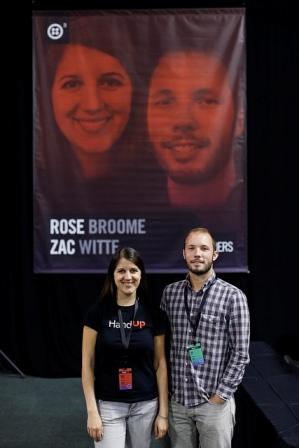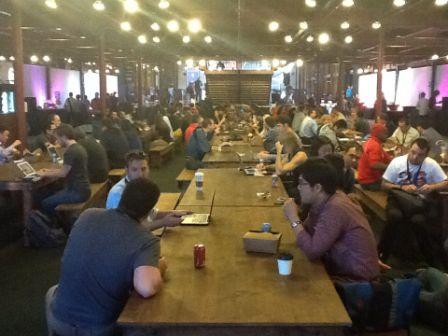A perspective on the 2013 Twilio Conference in San Francisco
A lot of the best technology excitement these days emanates from the customer conferences for the new innovative social, cloud and mobile platforms that are busy disrupting the IT world. These faces of the cloud revolution are the Homebrew Club meetings of our age, although with much bigger audiences and significantly better production values!
Just looking at this month: if you were in Washington, D.C. on Sept. 8, then the Tableau conference was the place to be, watching Nate Silver and others join Christian Chabot who went, in the flash of an eye, from discovering the size of the universe and breaking the Mayan code to introducing his developers to show new product features. If you woke up in San Francisco the weekend of Sept. 15, then Boxworks was the place to be with Malcom Gladwell and Geoffrey Moore joining Aaron Levie to show how mobility is fundamentally changing the nature of work; and Aaron also went on to demonstrate how Blink182 aids mobility. And last week starting Sept. 17 in San Francisco, the TwilioCon3 conference, in the same offbeat building as TechCrunch Disrupt the week before (see picture below), brought Jeff Pulver, Mitch Kapoor, Tim O’Reilly and Dr. Mae Jemison from space to join Twilio CEO Jeff Lawson in exploring the outer limits of cloud-accelerated communications.

Twilio, founded in 2007 by Jeff Lawson, Evan Cooke, and John Wolthuis, has the mission of empowering the world’s Web-style developers in building whatever communications applications they want by deconstructing classical PBX, IVR, conference bridge and SMS/MMS functionality and turning it all into high-scale cloud components that can be easily programmed through XML scripts (“TwiML”), REST interfaces and HTTP callbacks. Twilio also consolidates and simplifies carrier access making it easy to buy phone numbers from tens of countries across the world as well as SMS short codes and long codes, and even this can even be done programmatically. This approach has allowed all kinds of applications to be built, each of which uses whatever mix of global communications capabilities it needs for its particular customer or business process. Twilio-based apps now handle four million calls a day and have reached some 350 million people globally.
TwiloCon is therefore unabashedly targeted at modern Web-style software developers. “We can’t wait to see what you will build” is Jeff Lawson’s long-time secret mantra that he shared with everyone in his opening remarks to the conference. In keynotes on both main days of the conference many “DOers,” as Twilio calls its customers who are building applications, were highlighted and some brought to the stage. For example: Home Depot, Real Page, Hulu, Datalot, Wiz, LiveOps, HandUp, the Polaris Project and many more. The walls of the main theater were decorated with huge posters of individual DOers, many of whom were at the conference to receive this recognition (for example, see the picture below). Jeff Lawson emphasized “building” apps by writing and executing code on main-stage to send messages to all attendees, and his keynote was bracketed by a preparatory workshop day of hands-on coding and a four-and-a half hour “Hacker Olympics” in the evening where over 20 teams competed for prizes amidst fun, games and music.

The culture was therefore young, appreciative of the loud music, very predominantly MacBook, and very open to sharing and talking to new people as everyone sat around on the cool wooden benches and tables that created a cool collegiate vibe. Although not yet well balanced there were a lot more developers of color and women speakers, keynoters and coders, including on the winning Hacker Olympics team, than I have seen at a number of other recent tech shows. Chatting with many people showed a lot of entrepreneurial CTOs and technical CEOs from new ventures. One of the funniest moments for me was watching an industry analyst colleague of mine try to explain to a young coder/CEO exactly what an analyst’s “product” was and why people would want to buy it!

I emphasize the culture here because I think this one of the most important forces to come out of leading edge social/mobile/cloud gatherings like TwilioCon. The call to tribal unity was, in fact, completely explicit across the keynotes. Jeff Lawson positively named the tribe “Software People” and “DOers” and talked about the whole world moving to software defined solutions where “it is good to build.” He rejected traditional monolithic “solutions” requiring lots of time to install and customize as not being effective solutions at all, while also typically being based on fifteen year-old “designs.” It is much better, according to Jeff, to build exactly what you want using high-level APIs accessing easily composable cloud services.
The closing session of the conference was a chat with Twilio investors Ethan Kurzweil of Bessemer and Josh Stein of Draper, Fisher, Jurvetson. They said that software people were taking over the world, that there was a developer renaissance, that the “API economy” would drive next generation disruptive applications and the Internet of things, and they even quoted Rainer Maria Rilke to tell everyone to think big and not waste time on small plans. St. Elon Musk was discussed as the quintessential Software Person able to bend space, time, and electricity to his will by virtue of software-type thinking. Needless to say, this was all well targeted to the TwilioCon audience!
I have overviewed this with some humor, but the serious disruptive aspect of this new culture is the immense power now in the hands of today’s nearly 20 million worldwide Web-style software developers. They have rich social and mobile user experience models backed by staggering cloud power – globally distributed IaaS, rich open source tools and databases, and many kinds of pre-built cloud services, including Twilio’s cloud communications services. Two to six developers in a room can now build global applications that support tens of millions of users with all kinds of rich functionality – a software leverage that is unprecedented. I affectionately call this large new-generation Web-style developer community the "SoCoMoRT hordes" – and it is they who have already created the social app revolution that surrounds all of us every day.
Many have gone on to target the enterprise such as Salesforce and Workday though to Box, Jive, Tableau and many others. New easily accessible communications technologies, like Twilio’s cloud APIs, other real-time and mobile back-end services, and WebRTC, put real-time communications directly in the hands of these millions of developers, so they don’t have to be beholden to any traditional enterprise or carrier communications vendors. They can just build the real-time functionality they need directly into their mobile applications and browser interfaces. I think we are only just beginning to see the innovation that this makes possible.
On the second day of the conference, Twilio decided to spend all of its keynote time, and a number of follow-on sessions, on “Building for Good” and empowering people to give back to communities globally. This was both a reflection of Twilio’s values and also a powerful crossover-theme well received by this particular tribe. Jeff announced Twilio.org whose goal is to provide “a billion messages for good” through credits and discounts for nonprofits working to make a real impact in the world.
Example “DOers” for good at the conference included: HandUp.us, working to crowdfund donations to people in need in your neighborhood; Ideo.org, working with a “CrapMap” application in Ghana to improve sanitation; and PolarisProject.org, working for a world without slavery using hotlines and SMS to help people free themselves from human trafficking in the U.S. (see this article). In each case, there were surprising uses of voice and text conversations and automation targeted to the specific use case needs of their audience. Tim O’Reilly and Mitch Kapor delivered compelling follow-on keynotes combining impassioned calls for social engagement with practical entrepreneurial advice for the audience (see a short summary of their talks here).
So what was actually new with Twilio technology?! Sorry to leave this to last, but I hope to have suggested by now that actual feature updates are the waves on top of deeper cultural and social, cloud and mobile technology ocean swells! Big news was the introduction of MMS picture messaging at a cost-effective rate allowing the sending and receiving of pictures to mobile devices to be incorporated into programmed application workflows. Costs for regular text messaging were also reduced and new automation for handling long “concatenated” 1,600 character messages added. Text messaging is often under-appreciated by communications specialists but is an important part of any notification, verification, security and other application workflow built by Twilio customers. I am sure you know that some audiences (like our kids) text way more than they talk and that over 90 percent of texts actually get read – more than many other channels!

Twilio SIP has been extended to now provide outbound connections as well as the previous inbound connections. This will allow Twilio applications to be fully wrapped around existing enterprise systems, providing new ways of quickly building new applications without needing to upgrade systems (except for having SIP connectivity). The previously introduced WebRTC functionality within Twilio Client continues to be enhanced and at the conference we saw multiple companies showing how they were using Twilio Client with WebRTC for better integrated and higher quality voice communications over the Web, including ringDNA, LiveOps, Zendesk and Datalot. When asked, Twilio leaders talked about looking at WebRTC video support as a roadmap item, but there are no announcements at this time. So the role that Twilio will play in the emerging WebRTC infrastructure space in relation to other vendors who are specifically enabling WebRTC browser and mobile voice, video and p2p data sharing remains to be seen.
Underneath the application features were a range of significant enhancements to allow developers to deploy mission critical applications with confidence. This included the Request Inspector, App Monitor, Usage triggers, Error triggers and Compliance and Security Settings. Together these provide comprehensive end-to-end visibility, diagnostics and control for developers building ever more sophisticated and critical applications on the Twilio platform. The considerable effort Twilio has expended on these management capabilities is a testament to the growing maturity of their how their platform is used very day by millions of people. More details on these and the other newly announced features can be found here.
To conclude, many of the new Twilio capabilities announced were incremental, but were well received by developers who use and need these every day. The considerable investment in deployment information and control was very encouraging for the rapidly growing Twilio application ecosystem. But, far and away the most enjoyable part of the conference was the energy, fun and cultural openness where you just sat down and talked to anybody about what they were doing. The conference setting, design, the keynotes, the workshops, sessions and “Hacker Olympics” were all focused on aligning the Software People, telling them “it’s ok to build” and sending these energetic developers forth with expanded tools to create new applications. The confidence of the developers there that they could easily mash Twilio APIs with whatever languages, mobile and HTML5 tools, and other cloud services they were using to produce new applications was palpable. As the mantra says: we can’t wait to see what you will build.
Edited by
Alisen Downey